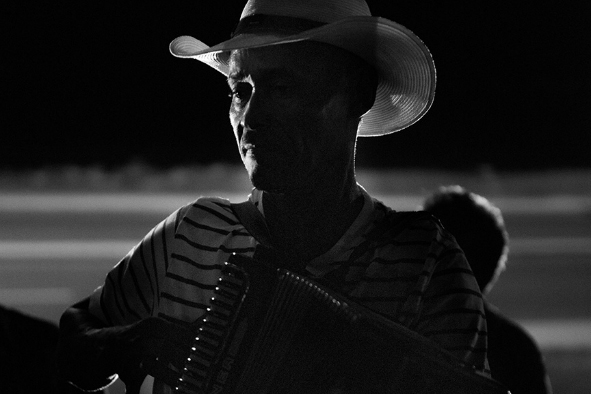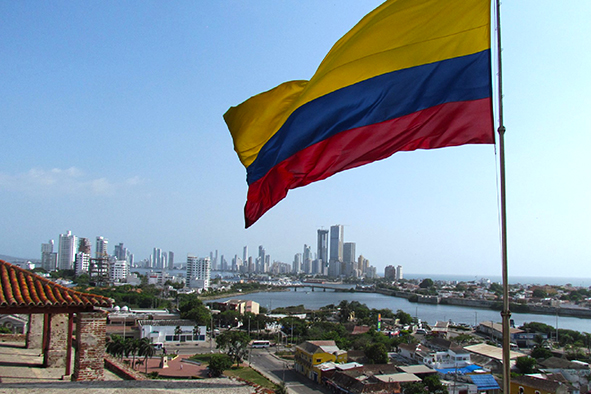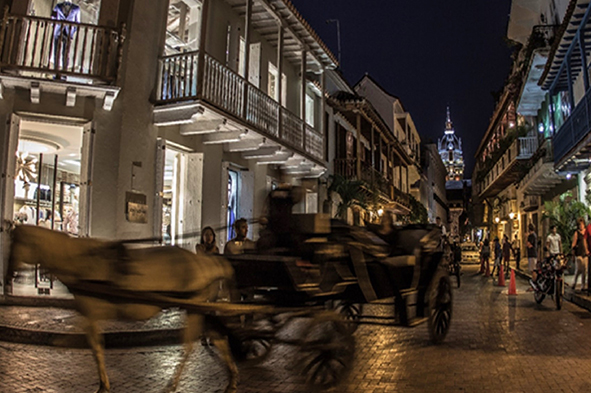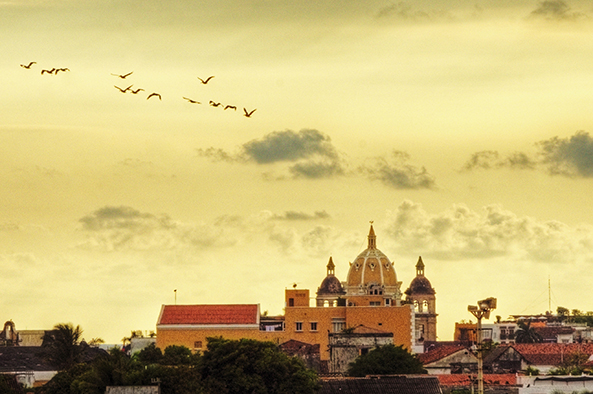In Colombia’s sweltering city of Cartagena, vallenato music tells the story of a people and a culture like no other. Stephen Woodman explores the music encountered along the streets and inside the buildings of Cartagena.

A vallenato accordionist in Cartagena (Photo: Louis Vest via Flickr / CC BY 2.0)
The humidity was the first thing I noticed as I stepped from the plane in Cartagena, Colombia. The bear hug embrace of the Caribbean air was so implausibly powerful that it was difficult to believe that locals didn’t still find the weather a daily shock.
The second thing I noticed – in the airport, on the taxi ride to the hotel, on the streets of the city center – was another of the colonial city’s features that was almost as persistent: the music that was everywhere, at all times of the day. Reggaeton, cumbia and salsa all had their listeners, but it was vallenato that ruled. Open a door or window in Cartagena and chances are vallenato comes pouring out.
The music is native to Colombia’s Caribbean coast, and reflects the mixing of African, European and indigenous cultures.
Vallenatos are typically produced by three instruments: an accordion, from Europe, the caja, a drum that originated among African slave communities, and the guacharaca, a wooden percussion instrument invented by the native Tairona people.
The music is so central to the identity of the region that UNESCO has added the genre to its list of “Intangible Cultural Heritage in Need of Urgent Safeguarding.”
“Vallenato music was born as an expression of the community,” said Marcos Fidel Vega Seña, a journalist and the author of the book ‘Vallenato: Culture and Feeling.’ “Through songs to lovers, songs to the land, songs to friendship, vallenato singers respond to the symbolism and values of the Caribbean.”

A Colombian flag dances in the wind at the San Felipe de Barajas Castle (Photo: Stephen Woodman)
Francisco the Man
Like any good tourist, I spent my first day in Cartagena exploring the walled city’s most iconic sights: the cathedral, the Inquisition Palace and San Felipe de Barajas Castle, a huge, pyramid-shaped fortress with a network of underground tunnels.
In the northern corner of the old city I found the seafront vacation house built by late Colombian novelist Gabriel Garcia Marquez.
Cartagena was where Garcia Marquez started out as a journalist, and although he lived most of his adult life in Mexico, he would return to the port city for a few weeks every year.
The connection with the Nobel laureate, who died in 2014, has helped Cartagena establish a reputation as a major literary hub.
Every year, top writers, poets and intellectuals descend on the Santa Clara Hotel for the Hay Literary Festival, the first event of its kind to be held outside of Wales.
Yet Garcia Marquez always maintained that his greatest influences were extra-literary.
“More than any book, I think what opened my eyes was music, vallenato songs… What called my attention most of all was the form the songs used, the way they told a fact, a story… All quite naturally,” he said.
In fact, the writer’s admiration for vallenato singers seems to have bordered on envy.
“I had dreamed about the good life,” he wrote in his memoir. “Going from fair to fair and singing with an accordion and a good voice, which always seemed to me to be the oldest and happiest way to tell a story.”
Such was the writer’s affection for the genre that he featured the mythical figure of Francisco the Man in his most celebrated novel, “One Hundred Years of Solitude.” According to Colombian folklore, Francisco was an expert in the piqueria, a dual of competitive improvisation between two singers – think battle rap with accordions – that remains an important part of vallenato culture today.
Legend has it that the quick-witted singer defeated the devil in a dual of piqueria – thus earning himself the moniker Francisco the Man.

A street in central Cartagena (Photo: Stephen Woodman)
A Musical Hijacking
On my second day in the city, I took a horse and carriage through the city center. We passed down a web of narrow streets until we reached the main square, the Plaza of the Carriages. Noisy vendors were flogging souvenirs to tourists, while barbecue sticks sizzled under naked lights. A bright yellow clock tower lingered over it all, as dancers in traditional dress stepped rhythmically across the square.
At one time the plaza was packed with chained African slaves, who were jabbed and prodded by merchants as they stood waiting to be sold.
Cartagena was once the largest slave trading port in Spanish America, and this plaza was site of the city’s main slave market.
The practice of human enslavement still haunts the city, whether in the stone walls that were built by slave labor or in the chants and rhythms of the vallenatos that fill the local airwaves.
As the carriage turned slowly into another lane, a young man with a guitar shouted something to the driver, who nodded his permission for him to jump onboard. He was one of the city’s many wandering troubadours, plying his trade by singing songs of broken-hearted love to the tourists gaping at the city’s architectural beauty.
Over the sounds of hooves on rough cobblestones, the new passenger struck into song, his fingers gliding swiftly across the fretboard. It was an excellent rendition of “The Cold Drop”, a classic piqueria that evolved from the rivalry between the singer Emiliano Zuleta, and his rival, Lorenzo Morales.
“Little Morales thought that
He would beat me,
But when he heard me playing
He broke into a fearful cold sweat.”

A horse and carriage passes through central Cartagena (Photo: Jairo Paez via Flickr / CC BY 2.0)
The “Goddess of Vallenato”
The late Mexican writer Carlos Fuentes described Cartagena as the “most beautiful city in the Caribbean,” and it’s easy to see why. Owing to this famed beauty, and because of the warmth of its locals and the constant, uplifting carnival atmosphere, the city is a difficult place to leave.
Thankfully, my next stop was only up the coast to Baranquilla. I don’t know if I would have survived the shock to the system of a direct flight to London’s Heathrow airport.
But from the shuttle bus out of town, I glimpsed a less glamorous side of the city that doesn’t make the postcards.
“Now you see both halves of Cartagena. The riches and the poverty,” said Raymundo, the driver.
Small grey houses, squashed together in rows, replaced the spacious homes and boutique hotels of the city center. Locals navigated the sidewalks with care. The broken and crumbling slabs of concrete betrayed the local government’s disinterest in this part of town.
Patricia Teheran, known as Cartagena’s “Goddess of vallenato”, was born and raised on this side of the city.
Her career began in 1988, when she signed with the Muses of Vallenato, one of the first all-female vallenato groups.
Singer Danny Cebollas performed with Teheran at the time.
“It was a novelty to see a woman singing vallenato,” Cebollas said. “It was a very macho genre. It still is in fact. Men don’t accept that women can be better performers.”
Teheran died in hospital at age 25 following a car accident on the same highway to Barranquilla that I was travelling along now. “I am not going to sing anymore,” were her famous last words.
Yet her voice continues to be heard. In the bars, clubs, houses, cars and restaurants of Cartagena, Patricia Teheran’s songs remain as popular as ever.

A Cartagena sunset (Photo: Mariusz Kluzniak via Flickr / CC BY 2.0)